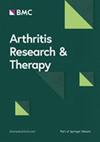Neutrophil and mononuclear leukocyte pathways and upstream regulators revealed by serum proteomics of adult and juvenile dermatomyositis
IF 4.9
2区 医学
Q1 Medicine
引用次数: 0
Abstract
Serum protein abundance was assessed in adult and juvenile dermatomyositis (DM and JDM) patients to determine differentially regulated proteins, altered pathways, and candidate disease activity biomarkers. Serum protein expression from 17 active adult DM and JDM patients each was compared to matched, healthy control subjects by a multiplex immunoassay. Pathway analysis and protein clustering of the differentially regulated proteins were examined to assess underlying mechanisms. Candidate disease activity biomarkers were identified by correlating protein expression with disease activity measures. Seventy-eight of 172 proteins were differentially expressed in the sera of DM and JDM patients compared to healthy controls. Forty-eight proteins were differentially expressed in DM, 32 proteins in JDM, and 14 proteins in both DM and JDM. Twelve additional differentially expressed proteins were identified after combining the DM and JDM cohorts. C-X-C motif chemokine ligand 10 (CXCL10) was the most strongly upregulated protein in both DM and JDM sera. Other highly upregulated proteins in DM included S100 calcium binding protein A12 (S100A12), CXCL9, and nicotinamide phosphoribosyltransferase (NAMPT), while highly upregulated proteins in JDM included matrix metallopeptidase 3 (MMP3), growth differentiation factor 15 (GDF15), and von Willebrand factor (vWF). Pathway analysis indicated that phosphoinositide 3-kinase (PI3K), p38 mitogen-activated protein kinase (MAPK), and toll-like receptor 7 (TLR7) signaling were activated in DM and JDM. Additional pathways specific to DM or JDM were identified. A protein cluster associated with neutrophils and mononuclear leukocytes and a cluster of interferon-associated proteins were observed in both DM and JDM. Twenty-two proteins in DM and 24 proteins in JDM sera correlated with global, muscle, and/or skin disease activity. Seven proteins correlated with disease activity measures in both DM and JDM sera. IL-1 receptor like 1 (IL1RL1) emerged as a candidate global disease activity biomarker in DM and JDM. Coordinate analysis of protein expression in DM and JDM patient sera by a multiplex immunoassay validated previous gene expression studies and identified novel dysregulated proteins, altered signaling pathways, and candidate disease activity biomarkers. These findings may further inform the assessment of DM and JDM patients and aid in the identification of potential therapeutic targets.成人和青少年皮肌炎血清蛋白质组学揭示的中性粒细胞和单核白细胞通路及上游调节因子
对成人皮肌炎和幼年皮肌炎(DM 和 JDM)患者的血清蛋白丰度进行了评估,以确定不同调控蛋白、改变的通路和候选疾病活动生物标记物。通过多重免疫测定法,将17名活跃的成年DM和JDM患者的血清蛋白表达与匹配的健康对照组进行了比较。对不同调控蛋白的通路分析和蛋白聚类进行了研究,以评估其潜在机制。通过将蛋白质表达与疾病活动指标相关联,确定了候选疾病活动生物标志物。与健康对照组相比,172 种蛋白质中有 78 种在 DM 和 JDM 患者的血清中表达不同。其中48个蛋白质在DM患者血清中有差异表达,32个蛋白质在JDM患者血清中有差异表达,14个蛋白质在DM和JDM患者血清中均有差异表达。将 DM 和 JDM 组群合并后,又发现了 12 种不同表达的蛋白质。C-X-C motif趋化因子配体10(CXCL10)是DM和JDM血清中上调最强烈的蛋白质。其他在DM中高调的蛋白质包括S100钙结合蛋白A12(S100A12)、CXCL9和烟酰胺磷酸核糖转移酶(NAMPT),而在JDM中高调的蛋白质包括基质金属肽酶3(MMP3)、生长分化因子15(GDF15)和von Willebrand因子(vWF)。通路分析表明,磷酸肌醇3-激酶(PI3K)、p38丝裂原活化蛋白激酶(MAPK)和toll样受体7(TLR7)信号在DM和JDM中被激活。此外,还发现了 DM 或 JDM 特有的其他通路。在 DM 和 JDM 中都观察到了与中性粒细胞和单核白细胞相关的蛋白质集群以及干扰素相关蛋白质集群。DM血清中的22种蛋白质和JDM血清中的24种蛋白质与全身、肌肉和/或皮肤疾病活动相关。在 DM 和 JDM 血清中,有 7 种蛋白质与疾病活动度相关。IL-1受体样1(IL1RL1)成为DM和JDM中候选的整体疾病活动性生物标志物。通过多重免疫测定对 DM 和 JDM 患者血清中蛋白质表达的协调分析验证了之前的基因表达研究,并确定了新的失调蛋白质、改变的信号通路和候选疾病活动生物标志物。这些发现可为 DM 和 JDM 患者的评估提供进一步信息,并有助于确定潜在的治疗目标。
本文章由计算机程序翻译,如有差异,请以英文原文为准。
求助全文
约1分钟内获得全文
求助全文
来源期刊

Arthritis Research & Therapy
RHEUMATOLOGY-
CiteScore
8.60
自引率
2.00%
发文量
261
审稿时长
14 weeks
期刊介绍:
Established in 1999, Arthritis Research and Therapy is an international, open access, peer-reviewed journal, publishing original articles in the area of musculoskeletal research and therapy as well as, reviews, commentaries and reports. A major focus of the journal is on the immunologic processes leading to inflammation, damage and repair as they relate to autoimmune rheumatic and musculoskeletal conditions, and which inform the translation of this knowledge into advances in clinical care. Original basic, translational and clinical research is considered for publication along with results of early and late phase therapeutic trials, especially as they pertain to the underpinning science that informs clinical observations in interventional studies.
 求助内容:
求助内容: 应助结果提醒方式:
应助结果提醒方式:


